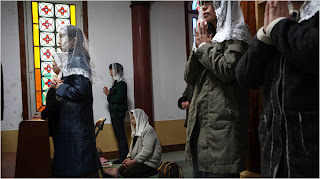Leave it to a commentator in Los Angeles — where trends begin and fashion queens reign — to understand, better than his counterparts in the East, that some of the pontiff’s most important pronouncements aren’t made with phrases, but with fabric.
From the LA Times:
Pope Benedict XVI’s visit to the United States later this month has inspired speculation about what the pontiff will say to his sometimes restive American flock. Will he use a lecture at Catholic University in Washington to chastise Catholic colleges and universities for succumbing to secularism? Will he make more than an oblique reference to the pedophilia scandal that led to the resignation of Cardinal Bernard Law as the archbishop of Boston (a city not on the pope’s itinerary)?
And there’s another interesting question for American Catholics on both the left and the right: What will the pope wear?
When Benedict celebrates Mass in Yankee Stadium on April 20, he will be clothed in the raiment of his office — a poncho-like vestment called a chasuble and the double-peaked bishop’s cap known as a miter. Asking if the pope will be dressed up is like asking whether the pope’s Catholic.
But the Catholic Church is a house with many rooms, and those rooms have different clothes hanging in the closets. To the delight of conservative Catholic bloggers, Benedict — the pope who has ordered wider use of the Latin Mass of the Council of Trent — has lately been donning elaborately embroidered vestments and miters in what is called the “Roman” style, in contrast with the neo-medieval “Gothic” style that made a comeback after the Second Vatican Council.
The Gothic style features short, squat miters and full, flowing chasubles. The Roman style, a product of the Baroque era, produced the super-tall miters beloved of anti-Catholic polemicists (the cartoonist Thomas Nast portrayed bishops as crocodiles, with the two points of their miters forming jaws) and chasubles reduced to the point that they resemble an embroidered sandwich board. This style of chasuble is known as the “fiddleback” because the front portion is shaped like a violin.
Fiddleback chasubles and skyscraper miters were the norm in the Roman Catholic Church through the early part of the 20th century. The Gothic style, which hearkened back to the 12th century, was viewed with suspicion in Rome partly because it was favored by priests of the Church of England who wanted to reestablish their church’s Catholic heritage. (Ironically, some of those “Anglo-Catholic” clergymen were imprisoned in the 19th century for wearing what Protestant-minded Anglicans regarded as the “rags of popery.”)
But the Gothic revival was also supported by some Roman Catholic scholars, the same scholars whose studies laid the groundwork for the liturgical reforms — including Mass with the priest facing the congregation — that followed the Second Vatican Council. In a 1931 book celebrating Gothic vestments, the influential Benedictine monk E.A. Roulin fulminated against the “horribly heavy” and “vulgar” fiddleback chasuble.
When I served Mass as an alter boy at in Pittsburgh in the early 1960s, the vestments were all Gothic, the fiddlebacks of the 1940s and 1950s having long been mothballed. I didn’t realize, until I read Garry Wills’ “Bare Ruined Choirs,” that Gothic vestments were associated with liberal Catholicism.
After Vatican II, the pope caught up with Pittsburgh. When Pope Paul VI celebrated Mass in Yankee Stadium in 1965, he wore a flowing but not particularly elaborate Gothic chasuble and a mid-sized miter. His successors — John Paul I and John Paul II — also favored Gothic chasubles, though they occasionally donned skyscraper miters.
Then the papacy passed to Cardinal Joseph Ratzinger, a critic of post-Vatican II liturgical practices who traced his own vocation to the priesthood to a youthful infatuation with the old Mass as it was celebrated in Baroque-loving Bavaria. In a 1997 memoir, Ratzinger recalled how “it was a riveting adventure to move by degrees into the mysterious world of the liturgy which was being enacted before us and for us at the altar.”
Assisted by Archbishop Piero Marini, the papal master of ceremonies he inherited from John Paul II, Benedict sported Gothic vestments and modest miters for a while. But last year, the pope replaced Marini with a prelate with the same last name, Msgr. Guido Marini. With the assistance of Marini No. 2, Benedict has returned to his liturgical roots, sporting massive miters, celebrating Mass in the Sistine Chapel with his back to the congregation and leading Good Friday services vested in a fiddleback chasuble. The pope’s aides say that his choice of vestments is designed to demonstrate continuity with the church’s past. Liberals are more inclined to see it as a slap at the spirit of Vatican II.
Read on at the link for some of the history behind all this.

